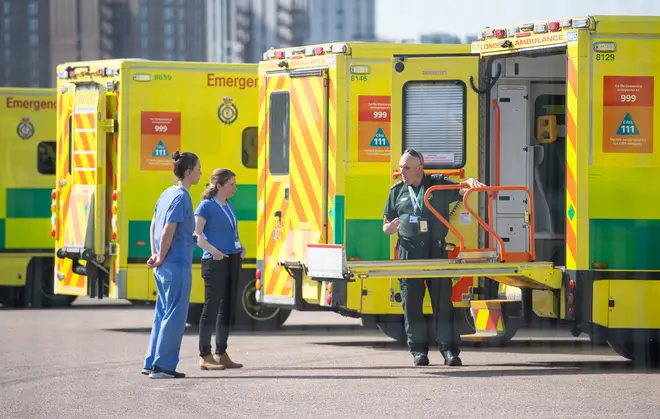
Shelagh Fogarty 1pm - 4pm
12 November 2020, 21:46 | Updated: 12 November 2020, 22:01

Shocking new figures show the number of people waiting more than a year for hospital treatment in England is at its highest level since 2008 as the UK records its highest daily number of coronavirus cases since the pandemic began.
Data from NHS England shows almost 140,000 people had to wait more than a year to start hospital treatment as of September.
This is the highest level since 2008, with patients usually expected to be seen within 18 weeks.
The harrowing figures came as the UK recorded its highest daily number of coronavirus cases since the pandemic began, with concern that infections are rising quickly among the elderly.
The most recent figure is the worst in over a decade and a stark demonstration of the knock-on impact of halting many non-emergency procedures during the first Covid-19 wave.
Surgeons have said it is "tragic" for patients to be left in pain while they wait for treatment, with many warning the situation could become even worse during winter.

Chris Hopson: Hospital waiting times 'not an ideal situation'
Chris Hopson, NHS providers Chief Executive, told LBC "it’s clearly not an ideal situation."
"But this is what the NHS does when it comes under real pressure, it prioritises on the basis of clinical need," he explained.
Read more: 'R' number 'drops below 1 in the UK,' according to Covid study app
Read more: Economy bounces back 15.5% after spring coronavirus lockdown
139,545 people had waited more than a year to start treatment as of September - in September 2019, the figure was just 1,305.
The data from NHS England also shows 1.72 million people were waiting more than 18 weeks to start treatment in September, up from 672,112 in September 2019.
The total number of people admitted for routine treatment in hospitals in England was also down 27% in September compared with a year ago - 209,562 patients were admitted for treatment during the month, down from 288,230 in September 2019.

Daughter forced to leave uni due to lack of hospital appointments
In recent weeks, major hospitals in Bradford, Leeds, Nottingham, Birmingham and Liverpool, which have seen high rates of infection, have announced the mass cancellation of non-urgent work.
And on Wednesday, new data suggested that the number of patients being treated for Covid-19 in hospitals in the North of England has surpassed the number at the peak of the first wave.
In the North West almost 3,000 hospital patients with confirmed Covid-19 were reported on Monday - dozens more than at the peak on 13 April.
Read more: Students given '7-day window' to return home for Christmas
Read more: Rapid £10 Covid 'bubble test' launched for groups of up to 10 people
In Yorkshire and the North East, 2,999 patients were reported on the same day this week - over 400 above a report on 9 April.
Together, both regions currently account for 52% of Covid-19 hospital patients in England.
They are currently the only regions so far to have passed their first-wave peak, though other areas appear to be heading in the same direction.

Three members of the same family die with COVID-19 in five days
It comes amid the news that another 33,470 lab-confirmed cases of Covid-19 were recorded in the 24 hours before 9am on Thursday, according to the latest Government figures.
Dr Yvonne Doyle, medical director at Public Health England, said the highest rates of infections were among younger generations.
But she said: "Worryingly it is rising quickly in those over 80 who are most at risk of poor outcomes.
"The current measures are in place to help protect all of us, and anyone can suffer serious illness from this virus."
Read more: Experts tell MPs compulsory Covid vaccines can be made legal
Read more: Boris Johnson claims big Government PR bill was to 'fight anti-vaxxers'
Research by Imperial College London's React study suggested around 100,000 new coronavirus infections were occurring per day in England at the start of the second lockdown last week.
Experts said infections rose sharply across the country with more than one in 80 people infected, double that reported in early October. They observed a drop in prevalence at the end of October but then a quick uptick at the start of November.

Which areas will benefit from Covid rapid testing?
Siva Anandaciva, chief analyst at the King's Fund, said staff were working hard to meet the health needs of people with and without Covid-19.
But he said it was "already clear that hospitals are having to prioritise the sickest patients and once again delay some planned procedures".
He added: "With nearly 140,000 people now waiting over a year for care and the worst of winter yet to come, it's clear the NHS won't be back to 'normal' any time soon.
NHS England said A&E attendances at hospitals in England continue to be below levels of a year ago, which is is "likely to be a result of the Covid-19 response" - suggesting that people are still staying away from A&E departments because of the coronavirus outbreak.
A total of 1.6 million attendances were recorded in October 2020, down 26 per cent from 2.2 million in October 2019.
The year-on-year drop in A&E attendances of 26% in October compares with falls of 20% in September, 19% in August and 30% in July.
Figures also show that a total of 199,801 urgent cancer referrals were made by GPs in England in September 2020, up from 195,196 in September 2019 - a rise of 2%.
Urgent referrals where breast cancer symptoms were present - though not initially suspected - were down from 13,475 in September 2019 to 10,963 in September 2020, a fall of 19%.